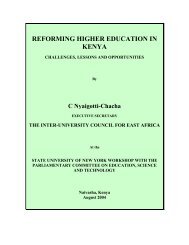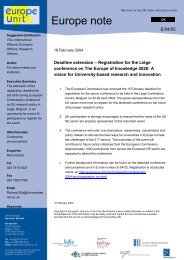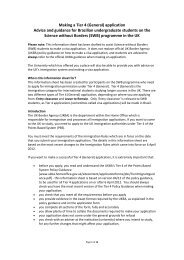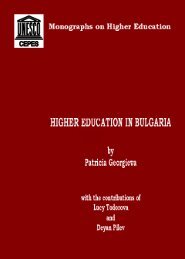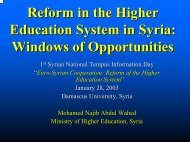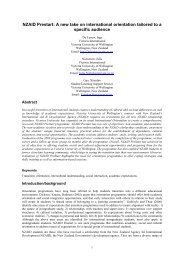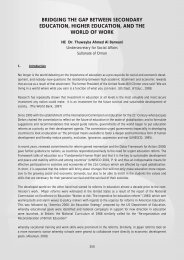POSITIONING TO MEET GLOBAL COMPETITION: THE HIGHER ...
POSITIONING TO MEET GLOBAL COMPETITION: THE HIGHER ...
POSITIONING TO MEET GLOBAL COMPETITION: THE HIGHER ...
You also want an ePaper? Increase the reach of your titles
YUMPU automatically turns print PDFs into web optimized ePapers that Google loves.
International forum: “Globalization and Integration in higher education”<br />
Asian and North American universities are most concerned with the risk of increased cost<br />
while African, Middle Eastern, and European universities feared brain drain. Latin<br />
American universities, on the other hand, were most concerned with the possible loss of<br />
cultural identity.<br />
3 PHILIPPINE <strong>HIGHER</strong> EDUCATION AND <strong>GLOBAL</strong>IZATION<br />
In the Philippines, higher education institutions total 1,647 (CHED, 2006) of which<br />
private colleges and universities comprise 89%. State colleges and universities,<br />
city/provincial, and other government schools represent the remaining 11%. Higher<br />
education has always been led by the private sector. Private higher institutions are<br />
established under the Corporation Code of the Philippines and are governed by special<br />
laws and general provisions of this Code. There are basically two categories: the nonsectarian<br />
and the sectarian ones, which are owned and run by religious organizations.<br />
Generally, Philippine private higher education institutions are covered by the policies,<br />
standards, and guidelines of the Commission on Higher Education (CHED). This covers<br />
program offerings, curriculum, administration and faculty academic qualifications, among<br />
others. A total of 79 private higher education institutions have autonomy or deregulated<br />
status in recognition of their quality education, research, and extension work.<br />
Public higher education institutions, on the other hand, are largely state colleges and<br />
universities, which are established by law, administered and financially subsidized by the<br />
government. The state universities have their own charters and have a Board of Regents<br />
(Board of Trustees for state colleges) that formulates and approves policies. The Board is<br />
headed by the Chairman of the CHED or by one of the four commissioners. There are<br />
also a few universities and colleges established and financially supported by the local<br />
governments through resolutions or ordinances, as well as a handful of CHED supervised<br />
institutions considered as non-chartered public post-secondary education institutions.<br />
Higher education programs are also offered by public secondary and post-secondary<br />
education institutions with usually a technical-vocational nature. Finally, there are special<br />
higher education institutions directly under a government agency as stipulated in the law<br />
that created them to provide specialized training in areas such as military science and<br />
national defense.<br />
The impact of globalization in the Philippines is perceived to be good by a majority of the<br />
Filipinos. According to the AC Nielsen (2006) online survey conducted in November<br />
2005 among 23,500 regular Internet users in 42 markets in Europe, North America, Asia-<br />
Pacific, Latin America, South Africa, and the Middle East, consumers in the Philippines,<br />
Malaysia, Taiwan, South Africa, and India unanimously agree on the value of<br />
globalization. It is notable that 73% of the Filipinos surveyed agree that globalization has<br />
brought increased job and career opportunities. While the reference was not specific to<br />
higher education, the survey has important implications for the sector. Globalization<br />
requires that the demand for Philippine labor should be matched by a supply of graduates<br />
with relevant courses.<br />
In developing countries, however, there is very limited factual information about the<br />
impact of globalization on higher education. In the Philippines, there are scattered cases<br />
of universities entering into various modes such as: 1) the development of e-courses; 2)<br />
international apprenticeship programs like in the fields of nursing, hotel and restaurant<br />
management, agriculture, and IT; 3) sisterhood agreements; 4) faculty/student exchanges;





